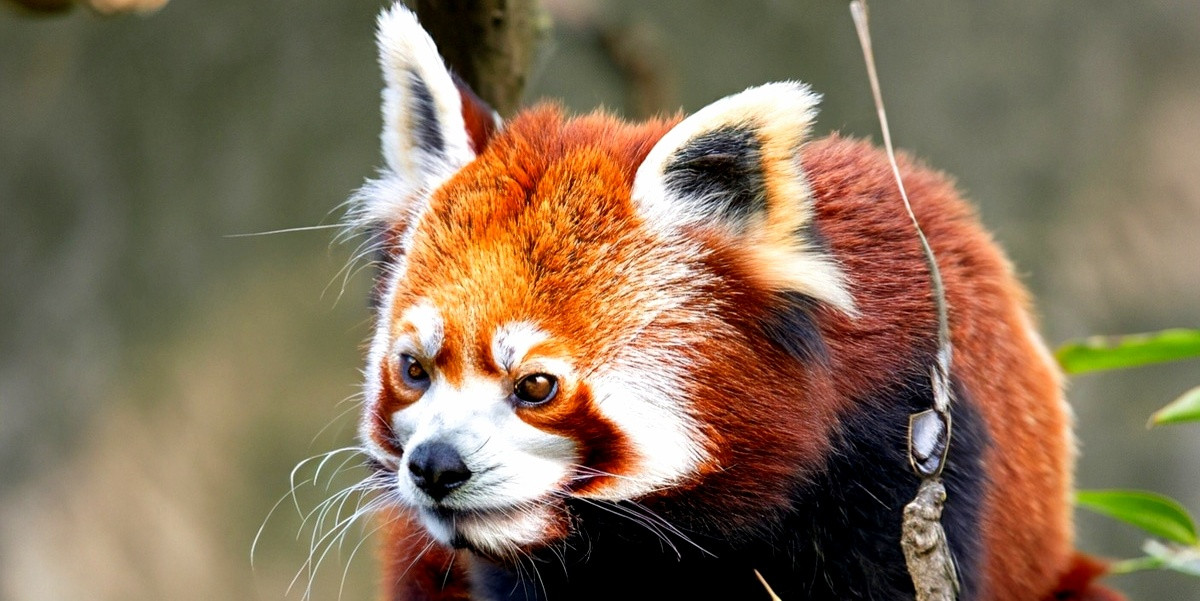Snow Leopard
The Snow Leopard (Panthera uncia) is one of the most enigmatic and elusive animals in the world, often referred to as the "ghost of the mountains" due to its solitary and secretive nature. These magnificent cats are native to the mountain ranges of Central and South Asia, with a significant population found in the Himalayan region of Nepal. Here are some fascinating aspects of the Snow Leopard:
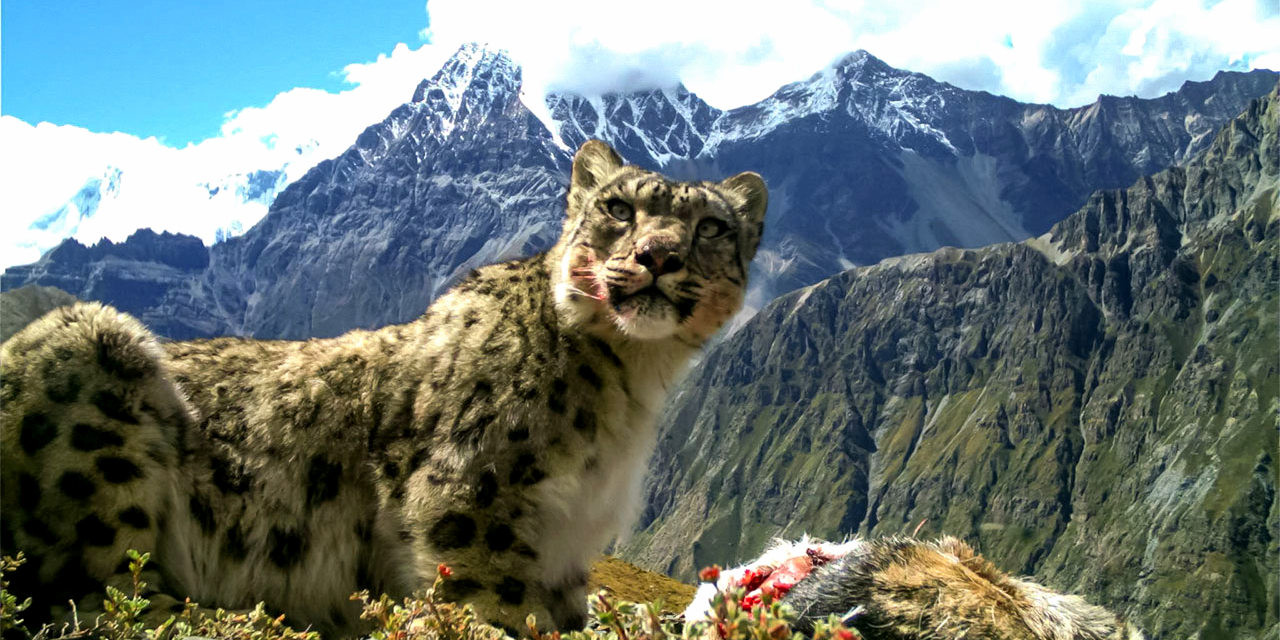
-
Physical Characteristics: Snow Leopards are medium-sized cats, smaller than other big cats like lions and tigers. They have thick, smoky-grey fur with black spots and rosettes, which provide excellent camouflage against the rocky terrain of their mountainous habitat. Their body is adapted to the cold, with a robust build, fur-covered feet, long tails for balance and warmth, and large nasal cavities for warming cold air.
-
Habitat: Snow Leopards are found at high altitudes ranging from 3,000 to 4,500 meters (9,800 to 14,800 ft), primarily in alpine meadows and rugged mountainous regions. They are highly adapted to living in steep, rocky terrains with sparse vegetation.
-
Diet and Hunting: Snow Leopards are carnivores, and their diet mainly consists of Himalayan blue sheep (bharal), Argali wild sheep, ibex, and smaller prey such as hares and birds. They are known for their ability to kill prey up to three times their own weight. The cat employs a strategy of stalking and ambushing, often pouncing from a considerable distance to capture their prey.
-
Behavior: Snow Leopards are solitary creatures, coming together only during the breeding season. They are crepuscular, being most active during dawn and dusk. Their home ranges are vast, several square kilometers in extent, and they use scent markings to communicate with other snow leopards.
-
Conservation Status: Classified as 'Vulnerable' by the International Union for Conservation of Nature (IUCN), the Snow Leopard faces several threats, including poaching for their beautiful fur and bones, retaliation killing by farmers protecting livestock, and habitat destruction. The global population is estimated to be between 4,000 and 6,500 individuals in the wild.
-
Conservation Efforts: In Nepal, conservation efforts for the Snow Leopard include anti-poaching patrols, community-based conservation projects, and education programs aimed at reducing human- wildlife conflict. International collaborations are also in place to enhance conservation strategies across the Snow Leopard’s range.
-
Snow Leopards and Tourism: Responsible wildlife tourism, like that promoted by Relax Getaways, plays a role in Snow Leopard conservation by increasing awareness and generating funds used for conservation projects. Visitors to the Himalayas may have the unique opportunity to spot these rare animals in their natural habitat, contributing to their protection through ecotourism revenues.
The Snow Leopard remains a symbol of the wild and unexplored regions of the Himalayas, embodying the mystery and beauty of these high-altitude landscapes. Through continued conservation efforts and sustainable tourism practices, there is hope for preserving this incredible species for future generations to marvel at and admire.
Red Panda
The Red Panda (Ailurus fulgens), often called the "firefox," is a small arboreal mammal native to the temperate forests of the Himalayas. Despite sharing the name panda, the Red Panda is not closely related to the Giant Panda. Instead, it represents its own unique family – Ailuridae. Endearing and elusive, Red Pandas are an iconic species of the eastern Himalayan region, including Nepal. Here's an in-depth look at this charming creature:
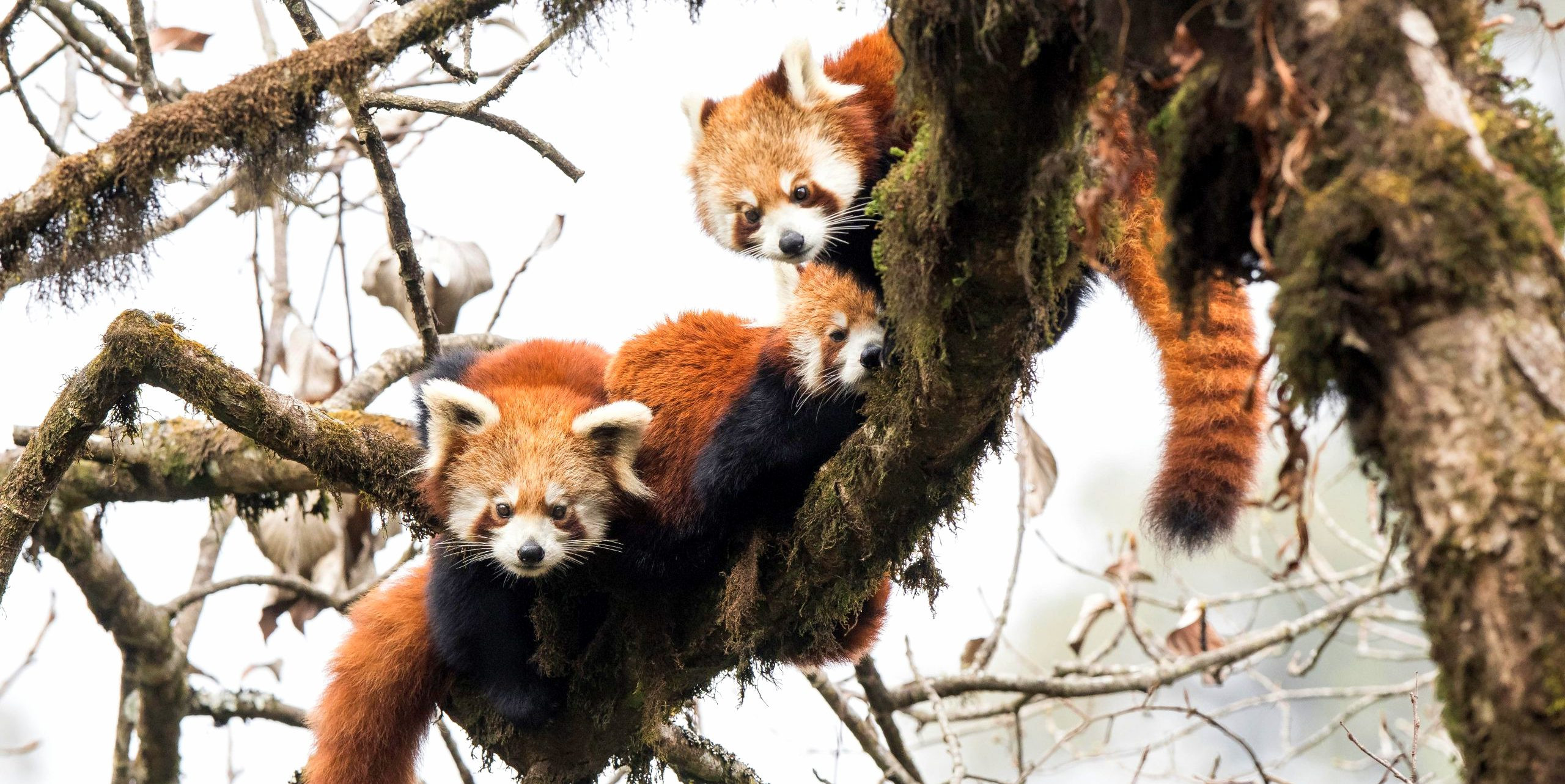
-
Physical Characteristics: Red Pandas are about the size of a domestic cat, with a bear-like body and thick russet fur. The belly and limbs are black, and there are white markings on the side of the head and above its small eyes. Perhaps their most distinctive feature is their long, bushy tail, which is ringed with alternating red and white bands and helps them balance in the trees.
-
Habitat: Red Pandas live in the cool temperate forests of the Himalayas, where there is a dense understory of bamboo. They are found at elevations between 2,200 and 4,800 meters (7,200 to 15,700 ft), preferring areas with a moderate climate with little annual variation. They use their sharp claws to climb trees and often sleep on the branches.
-
Diet and Feeding Behavior: Although classified as carnivores, Red Pandas are predominantly bamboo eaters, with bamboo shoots and leaves constituting more than 95% of their diet. They also eat fruits, acorns, roots, and eggs. Unlike many animals, they are most active during the day (diurnal), with peaks of activity in the early morning and late afternoon.
-
Behavior: Red Pandas are solitary and shy animals, only coming together for mating. They are very territorial; both males and females mark their territory with secretions from their anal glands and with urine. Communication occurs through a variety of sounds — from squeals and twitters during mating to deep threatening tones when fearful.
-
Conservation Status: The Red Panda is classified as 'Endangered' by the International Union for Conservation of Nature (IUCN) due to habitat loss, fragmentation, poaching, and the illegal pet trade. Their total population is estimated to be fewer than 10,000 mature individuals, with a continued decline expected unless significant conservation efforts are undertaken.
-
Conservation Efforts: In Nepal, several conservation initiatives are aimed at protecting the Red Panda. These include habitat restoration, community-based conservation programs that involve local people in wildlife monitoring, and awareness campaigns to reduce poaching and illegal trade. Protected areas and national parks play a critical role in providing refuge for these animals.
-
Red Pandas and Eco-Tourism: Eco-tourism initiatives, such as those offered by Relax Getaways, provide an opportunity to observe Red Pandas in their natural habitat while contributing to their conservation. Sustainable tourism practices help generate revenue for local communities and fund conservation projects, ensuring that visitors have a minimal impact on the species and their environment.
The Red Panda, with its distinctive appearance and endearing behavior, continues to capture the hearts of wildlife enthusiasts around the world. Efforts to conserve their habitats and reduce threats are crucial for ensuring that future generations will also be able to enjoy the presence of these unique animals in the wild.
Himalayan Musk Deer
The Himalayan Musk Deer (Moschus leucogaster) is a small and elusive herbivore native to the mountainous forests of the Himalayas. Known primarily for the male's secretion of musk, a substance highly prized in the perfume industry, the musk deer plays a significant role in its ecosystem and faces critical threats from poaching and habitat loss. Here’s a closer look at this unique species:
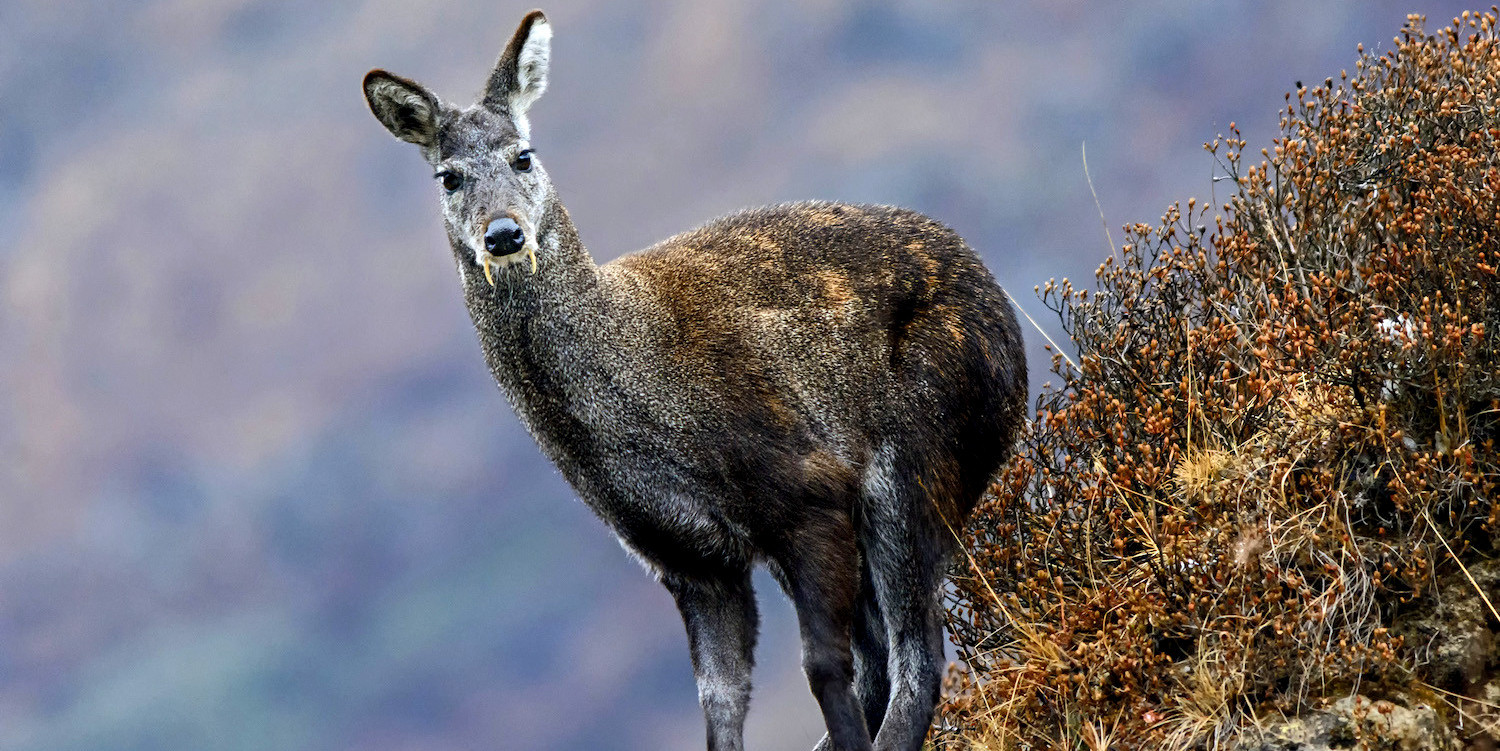
-
Physical Characteristics: Himalayan Musk Deer are relatively small, weighing between 7 to 17 kilograms (15 to 37 pounds). They lack antlers, which are common in most deer species; however, the males possess elongated canine teeth that protrude from the mouth like small tusks. These are used in mating battles as a display of dominance. The deer's coat is thick and coarse, generally brown with white spots, providing camouflage in their rocky, forested environment.
-
Habitat: These deer are found at elevations ranging from 2,500 to 4,300 meters (8,200 to 14,100 feet). They prefer dense forest habitats that offer both cover and a variety of understory vegetation. Himalayan Musk Deer are typically found in regions with hilly terrain, which provides them with the isolation and protection needed from predators.
-
Diet and Feeding Behavior: Himalayan Musk Deer are browsers, feeding primarily on leaves, flowers, and grasses, with a particular preference for lichens during the winter months. They are known for their ability to survive on poor-quality vegetation in harsh climates, adapting their diet based on seasonal availability.
-
Behavior: Musk Deer are solitary and highly secretive animals, mostly active during the early morning and late evening. They are shy and quiet, making them difficult to spot in the wild. Their solitary nature increases during the winter when the males become more territorial, marking their terrain with secretions from their musk gland to attract females and deter other males.
-
Conservation Status: The Himalayan Musk Deer is classified as 'Endangered' by the International Union for Conservation of Nature (IUCN). The primary threat to their survival is poaching, driven by the high demand for musk, which is used in high-end perfumeries and traditional medicines. Habitat destruction due to deforestation and expanding human settlements also poses significant risks to their populations.
-
Conservation Efforts: Efforts to protect the Himalayan Musk Deer include stricter enforcement of anti-poaching laws and international trade restrictions under the Convention on International Trade in Endangered Species of Wild Fauna and Flora (CITES). In Nepal, conservation programs are also focusing on habitat preservation and are involving local communities in conservation efforts to help monitor populations and reduce poaching activities.
-
Himalayan Musk Deer and Eco-Tourism: Eco-tourism, as promoted by organizations like Relax Getaways, plays a crucial role in the conservation of the Himalayan Musk Deer by raising awareness and generating funds that support local conservation initiatives. Watching these secretive creatures in their natural habitat offers a unique wildlife experience and encourages a greater appreciation for the biodiversity of the Himalayan region.
The protection of the Himalayan Musk Deer is vital not only for maintaining the ecological balance of the Himalayan forests but also for preserving the cultural heritage associated with this iconic animal. Through continued conservation efforts and sustainable tourism practices, there is hope for the recovery and preservation of this endangered species.
Himalayan Tahr
The Himalayan Tahr (Hemitragus jemlahicus) is a large ungulate native to the rocky mountainous regions of the Himalayas. Recognized for its rugged appearance and remarkable adaptability, the Himalayan Tahr is an integral part of the high-altitude ecosystems of Nepal, India, and Tibet. Here’s an in-depth look at this unique species:
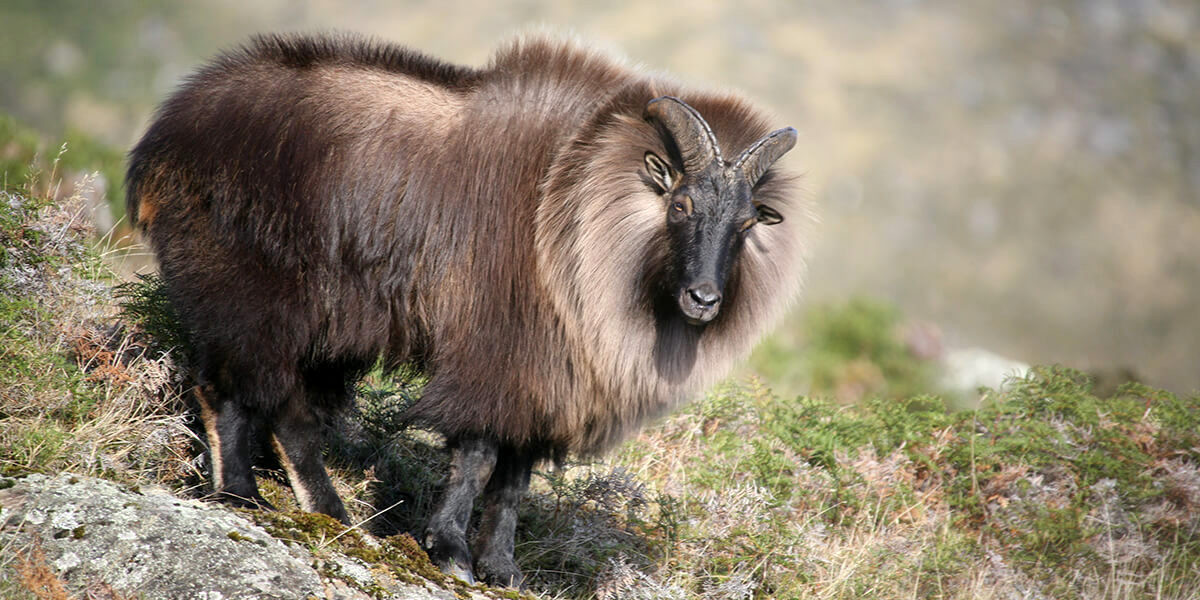
-
Physical Characteristics: Himalayan tahr are similar in size to goats but are more robust and sturdy. They weigh between 36 to 90 kilograms (79 to 198 pounds) and have a distinctive mane that runs down the back, which is more pronounced in males. The coat is thick and woolly, providing insulation against the harsh mountain climate, and changes color with the seasons for better camouflage—darker in the summer and lighter in the winter.
-
Habitat: Himalayan tahr are typically found at altitudes ranging from 2,500 to 5,000 meters (8,200 to 16,400 feet). They inhabit steep, rocky slopes and forested hillsides, which offer them protection from predators. Their ability to navigate this challenging terrain is exceptional, and they often seek refuge in nearly inaccessible areas.
-
Diet and Feeding Behavior: The diet of the Himalayan Tahr primarily consists of grasses, herbs, and leaves, with an occasional supplement of mosses and lichen. They are grazing animals but will browse when grasses are scarce, particularly in winter. Their feeding behavior is adapted to the sparse vegetation available at high altitudes.
-
Behavior: Himalayan tahr are social animals, often found in herds of up to 20 individuals, although larger groups of over 100 can be observed during certain times of the year. Herds usually consist of females and their young, while males often lead solitary lives or form bachelor groups. They are generally most active in the early morning and late afternoon.
-
Conservation Status: While not currently listed as endangered, the Himalayan Tahr is considered near threatened due to habitat loss and overhunting in some areas. Their populations in certain parts of the Himalayas are declining, and conservation measures are needed to ensure their survival.
-
Conservation Efforts: Conservation initiatives for the Himalayan Tahr include habitat preservation and management programs that aim to maintain the integrity of their natural environments. Efforts are also made to regulate hunting within sustainable levels, especially in areas where they are considered a trophy animal.
-
Himalayan Tahr and Eco-Tourism: Eco-tourism initiatives, such as those promoted by Relax Getaways, contribute positively to the conservation of Himalayan Tahr by providing economic alternatives to hunting and reducing the impact of human activities on their habitats. Observing these animals in their natural setting not only offers a unique wildlife experience but also raises awareness of the need for conservation in the Himalayas.
The Himalayan Tahr is a symbol of the rugged beauty and resilience of the Himalayan fauna. Their presence is a testament to the rich biodiversity of this region, and their conservation is vital for maintaining the ecological balance of the mountainous habitats they occupy. Through continued efforts in wildlife protection and responsible tourism, the future of the Himalayan Tahr can be secured.
Himalayan Monal
The Himalayan Monal (Lophophorus impejanus), also known as the Impeyan Monal, is a strikingly beautiful bird that dwells in the high-altitude environments of the Himalayan ranges. Esteemed as the national bird of Nepal, it is celebrated for its vibrant plumage and is a symbol of the region's rich biodiversity. Here’s a detailed look at this magnificent bird:
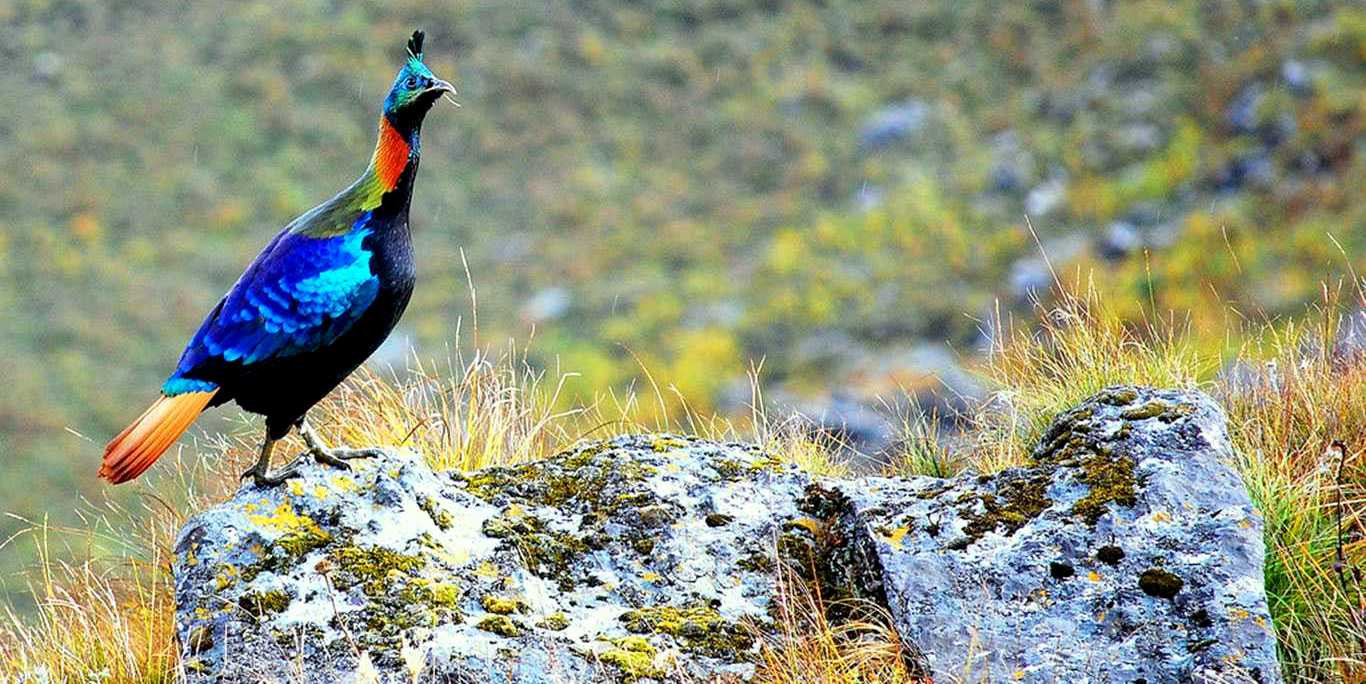
-
Physical Characteristics: The Himalayan Monal is a large pheasant, with males typically more colorful than females. Adult males display a remarkable range of iridescent colors; they have a metallic green head, a red and blue body, and a yellow-orange tail. Females, though less colorful, have a subtle beauty with their predominantly brown plumage speckled with white and buff. Both sexes have a distinctive white patch on the tail and a crest of feathers on their head, which they can raise or lower.
-
Habitat: This bird is found at altitudes ranging from 2,400 to 4,500 meters (7,900 to 14,800 feet), inhabiting open coniferous or mixed forests with dense undergrowth across the Himalayas. They are also seen in pastures and scrubby areas adjacent to the forests, where they search for food.
-
Diet and Feeding Behavior: The Himalayan Monal is omnivorous, feeding on a diet that includes tubers, roots, seeds, insects, and small vertebrates. During the summer, when food is plentiful, it grazes on grasses and herbs, whereas in the winter, it digs through the snow to find buried plant materials and invertebrates.
-
Behavior: Monals are generally shy and elusive, but males become very conspicuous during the breeding season due to their loud calls and striking colors, which they display to attract females. They are most active in the early mornings when they forage in small groups or pairs.
-
Conservation Status: The Himalayan Monal is currently listed as "Least Concern" by the International Union for Conservation of Nature (IUCN), although it faces threats from habitat loss and hunting. In many regions, they are hunted for their meat and the brilliant plumage of the males, which is used in traditional ceremonies and for decoration.
-
Conservation Efforts: Efforts to protect the Himalayan Monal include legal protection under national wildlife protection acts across its range, prohibiting hunting and trade of the bird. Conservation programs focus on habitat preservation, and awareness campaigns aim to reduce hunting pressures by educating local communities about the importance of biodiversity and the ecological role of the Monal.
-
Himalayan Monal and Eco-Tourism: Eco-tourism has a crucial role in the conservation of the Himalayan Monal, providing an alternative livelihood to local communities that might otherwise depend on hunting. Programs designed by organizations like Relax Getaways promote responsible wildlife viewing, which helps fund conservation efforts and increases public appreciation for this spectacular bird.
The Himalayan Monal remains one of the most iconic species of the Himalayan region, enchanting all who get a chance to glimpse its colorful display. By continuing to support habitat conservation and sustainable tourism practices, we can ensure that this magnificent bird thrives in the wild for generations to come.
Himalayan Black Bear
The Himalayan Black Bear (Ursus thibetanus laniger), also known as the Asian Black Bear or Moon Bear, is a medium-sized bear species native to the Himalayas and a significant part of the region's diverse wildlife. Known for its distinctive white "V" marking on the chest and its shaggy black fur, the Himalayan Black Bear is both revered and feared by local populations. Here's an in-depth look at this intriguing species:

-
Physical Characteristics: Himalayan Black Bears are relatively smaller than their American counterparts, with males typically weighing between 100 to 200 kilograms (220 to 440 pounds), and females are slightly smaller. They have a prominent mane around the neck, which adds to their bulky appearance. The bear's fur is long and shaggy, particularly suited to the cold Himalayan environment, with the chest marking varying in shape and clarity among individuals.
-
Habitat: These bears are found in a variety of forested habitats, ranging from tropical and subtropical to temperate broadleaf forests. They are typically located at altitudes from 1,500 to 3,000 meters (4,900 to 9,800 feet) but can be found up to 4,000 meters (13,000 feet) during the summer months as they follow the retreating snow upwards.
-
Diet and Feeding Behavior: The Himalayan Black Bear is omnivorous, with its diet comprising a mix of fruits, nuts, insects, small mammals, and carrion. They are particularly fond of acorns, chestnuts, and walnuts when these are available. Their ability to adapt their diet to seasonal availability is a key factor in their survival in the diverse climates of the Himalayas.
-
Behavior: These bears are predominantly nocturnal and spend a significant amount of time in trees, which provides them protection and a vantage point from which to forage or escape threats. They are known to be aggressive towards humans, more so than other bear species, particularly when surprised or when with cubs.
-
Conservation Status: The Himalayan Black Bear is classified as "Vulnerable" on the IUCN Red List due to habitat loss, poaching for their fur and body parts (used in traditional medicines), and conflicts with humans. These pressures have resulted in a declining population across their range.
-
Conservation Efforts: Efforts to conserve the Himalayan Black Bear include habitat conservation initiatives, anti-poaching measures, and programs designed to reduce human-bear conflicts, such as securing garbage and providing compensation for livestock losses. Education and outreach programs aimed at local communities also help in fostering coexistence.
-
Himalayan Black Bear and Eco-Tourism: Eco-tourism plays an essential role in the conservation of the Himalayan Black Bear by providing economic benefits that can fund conservation activities and by raising awareness about the bear's plight. Responsible ecotourism practices ensure that bear habitats are not disturbed and that humans can safely and sustainably observe these remarkable animals.
The Himalayan Black Bear remains a symbol of the wild and untamed nature of the Himalayas. Through continued conservation efforts, sustainable management practices, and responsible tourism, we can help ensure that future generations will also be able to witness the majesty of the Himalayan Black Bear in its natural habitat.
Rules and Regulations for Rare animals found in Himalayan region of Nepal
Nepal has established several rules and regulations to protect its rare and endangered wildlife, particularly those found in the Himalayan region. These laws are crucial for conserving biodiversity and maintaining ecological balance. Here's an overview of the key rules and regulations:
-
National Parks and Wildlife Conservation Act, 1973: This is the primary legislation that governs wildlife conservation in Nepal. It provides the legal framework for the protection of wildlife, conservation areas, national parks, and reserves. The act prohibits hunting, capturing, or killing of any wildlife species without a permit and outlines penalties for violations, including fines and imprisonment.
-
CITES Implementation: Nepal is a signatory to the Convention on International Trade in Endangered Species of Wild Fauna and Flora (CITES), which regulates the international trade of wildlife species and their products to ensure it does not threaten their survival. This includes many of the rare species found in the Himalayas, such as the Snow Leopard and Red Panda.
-
Community Forests and Conservation Areas: Nepal has pioneered the concept of community-managed forests and conservation areas, where local communities play a significant role in managing and protecting habitats. These areas often have their own set of rules, developed by the community, to safeguard the wildlife and natural resources.
-
Wildlife Reserves and Buffer Zones: Wildlife reserves and buffer zones around conservation areas have been established to provide additional habitat protection for rare species. Activities in these zones are strictly regulated to minimize human impact on the surrounding wildlife and ecosystems.
-
Protected Species List: The government of Nepal maintains a list of protected species under its national legislation. This list includes many rare animals found in the Himalayan region, and it is illegal to harm, hunt, or trade these animals in any form.
-
Anti-Poaching Units: To combat illegal hunting and trade, Nepal has set up anti-poaching units within the Department of National Parks and Wildlife Conservation. These units are equipped and trained to enforce conservation laws, conduct regular patrols, and engage in anti-poaching activities.
-
Environmental Impact Assessments (EIA): For any development projects in or near sensitive wildlife habitats, an Environmental Impact Assessment is required by law. This ensures that potential negative impacts on rare species and their habitats are considered and mitigated before project approval.
-
Wildlife Health Monitoring: Regular health monitoring and research are conducted to ensure the wellbeing of wildlife populations, particularly for rare and endangered species. This helps in managing diseases and other health-related issues that could adversely affect wildlife.
-
Public Awareness and Education: The government, along with various NGOs, conducts public awareness and education campaigns to inform and engage the local populations about the importance of wildlife conservation. These efforts are crucial for garnering community support and reducing human- wildlife conflicts.
-
Eco-Tourism Guidelines: Nepal promotes ecotourism as a way to support conservation while providing income for local communities. Guidelines ensure that tourism activities are conducted in an environmentally responsible manner, minimizing impact on wildlife and their habitats.
These rules and regulations are vital for the protection and preservation of the rare animals found in the Himalayan region of Nepal. By enforcing these laws and promoting sustainable practices, Nepal aims to safeguard its unique wildlife heritage for future generations.
The Himalayan region of Nepal is a critical habitat for a diverse array of rare and endangered species, such as the majestic Snow Leopard and the vibrant Himalayan Monal. These animals are integral to maintaining the ecological balance of this globally significant area. Faced with challenges like habitat destruction, climate change, and poaching, the success of conservation efforts in Nepal is vital not only for the survival of these species but also for the health of the entire ecosystem.
Nepal has made commendable efforts through robust legal frameworks, community involvement, and NGO partnerships to protect its wildlife. As global citizens, supporting sustainable tourism and conservation initiatives is crucial for ensuring that these rare species and the natural heritage they represent continue to thrive. By fostering global awareness and collaborative conservation, we can help preserve the natural beauty and ecological integrity of the Himalayas for future generations.
FAQs for Rare animals found in Himalayan region of Nepal
Q: What rare animals can be found in the Himalayan region of Nepal?
A: The Himalayas of Nepal are home to several rare animals, including the Snow Leopard, Red Panda, Himalayan Monal, Himalayan Tahr, Himalayan Black Bear, and the Himalayan Musk Deer.
Q: Why are these animals considered rare?
A: These species are considered rare due to their limited distribution, small populations, specific ecological niches, and threats such as habitat loss, poaching, climate change, and human- wildlife conflict.
Q: How is Nepal working to conserve these rare species?
A: Nepal employs various conservation strategies, including legal protection under national laws, establishment of wildlife reserves and national parks, community-based conservation projects, and collaborations with NGOs. Anti-poaching measures and habitat restoration are also crucial.
Q: Can tourists see these animals in the wild?
A: Tourists can see these animals in the wild, particularly during guided tours in national parks and conservation areas. Sightings are not guaranteed due to the animals’ elusive nature. Responsible ecotourism practices are encouraged.
Q: What can I do to help in the conservation efforts?
A: Visitors can help by supporting ecotourism, participating in conservation programs, spreading awareness about biodiversity, making financial contributions to wildlife conservation NGOs, and adhering to responsible tourism practices.
Q: Are there specific times of the year that are better for wildlife spotting?
A: The best times for wildlife spotting are during the dry seasons, specifically the pre-monsoon months of April and May and the post-monsoon months of October and November, due to better visibility and favorable weather conditions.
Q: What are the penalties for harming wildlife in Nepal?
A: Nepal has strict laws protecting wildlife, with penalties for harming or illegally trading wildlife, including heavy fines and imprisonment, depending on the species and the nature of the offense.
For the Nepal tour, please click here.
If you are looking for different kinds of Nepal Tours or Trekking Packages, feel free to contact us.
